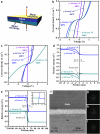III-V/Si hybrid photonic devices by direct fusion bonding
- PMID: 22470842
- PMCID: PMC3317235
- DOI: 10.1038/srep00349
III-V/Si hybrid photonic devices by direct fusion bonding
Abstract
Monolithic integration of III-V compound semiconductors on silicon is highly sought after for high-speed, low-power-consumption silicon photonics and low-cost, light-weight photovoltaics. Here we present a GaAs/Si direct fusion bonding technique to provide highly conductive and transparent heterojunctions by heterointerfacial band engineering in relation to doping concentrations. Metal- and oxide-free GaAs/Si ohmic heterojunctions have been formed at 300°C; sufficiently low to inhibit active material degradation. We have demonstrated 1.3 μm InAs/GaAs quantum dot lasers on Si substrates with the lowest threshold current density of any laser on Si to date, and AlGaAs/Si dual-junction solar cells, by p-GaAs/p-Si and p-GaAs/n-Si bonding, respectively. Our direct semiconductor bonding technique opens up a new pathway for realizing ultrahigh efficiency multijunction solar cells with ideal bandgap combinations that are free from lattice-match restrictions required in conventional heteroepitaxy, as well as enabling the creation of novel high performance and practical optoelectronic devices by III-V/Si hybrid integration.
Figures



References
-
- Seassal C. et al. InP microdisk lasers on silicon wafer: CW room temperature operation at 1.6 μm. Electron. Lett. 37, 222–223 (2001).
-
- Monat C. et al. InP-based two-dimensional photonic crystal on silicon: In-plane Bloch mode laser. Appl. Phys. Lett. 81, 5102–5104 (2002).
-
- Palit S. et al. Low-threshold thin-film III-V lasers bonded to silicon with front and back side defined features. Opt. Lett. 34, 2802–2804 (2009). - PubMed
-
- Tanabe K., Nomura M., Guimard D., Iwamoto S. & Arakawa Y. Room temperature continuous wave operation of InAs/GaAs quantum dot photonic crystal nanocavity laser on silicon substrate. Opt. Express 17, 7036–7042 (2009). - PubMed
-
- Tanabe K., Guimard D., Bordel D., Iwamoto S. & Arakawa Y. Electrically pumped 1.3 μm room-temperature InAs/GaAs quantum dot lasers on Si substrates by metal-mediated wafer bonding and layer transfer. Opt. Express 18, 10604–10608 (2010). - PubMed
LinkOut - more resources
Full Text Sources
Other Literature Sources

